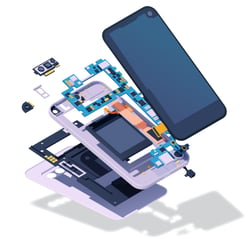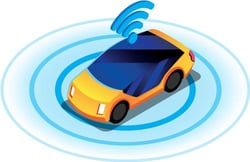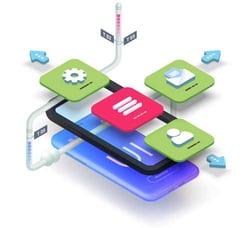 Ever since the launch of the first iPhone in 2007, consumers have grown accustomed to physical devices containing software systems. Every year, we're introduced to various new products with astonishing capabilities that directly impact our everyday lives. In addition to the products people use in their daily lives, there are many more products that we benefit from, even if the average person never interacts with them directly. From autonomous vehicles to sophisticated medical devices to space exploration, cyber-physical products are all around us and shaping our future.
Ever since the launch of the first iPhone in 2007, consumers have grown accustomed to physical devices containing software systems. Every year, we're introduced to various new products with astonishing capabilities that directly impact our everyday lives. In addition to the products people use in their daily lives, there are many more products that we benefit from, even if the average person never interacts with them directly. From autonomous vehicles to sophisticated medical devices to space exploration, cyber-physical products are all around us and shaping our future.
What Is Cyber Physical Development?
The development approach for a cyber-physical system is multi-disciplinary, requiring collaborative designing, testing, and deploying products closely integrated with sophisticated technology. Cyber-physical product development combines the best of both product development and software development.
If you're a company invested in creating the products of tomorrow, you know there are unique challenges involved. Because cyber-physical products rely on the intersection of the physical and software systems (not just the co-existing of the two), the development teams involved in each portion of the product need to work together effectively. This collaboration requires timely, clear communication and continuous alignment to the product goals; otherwise, there will be serious impacts on the overall process.
Unique Product Development Challenges
Product development as a whole is full of challenges. Syncing the cadence between different development teams, managing communication, sharing important data and customer feedback, and researching the market are all challenges that apply to any manufacturer. Add in the nuanced layers of cyber-physical product development, and product managers find themselves needing to navigate additional challenges throughout each product's lifecycle.
Challenge #1: The Importance of Connectability
 It's not enough to design a great-looking product. Cyber-physical products need to focus on connectivity. For starters, the hardware needs to support the software at the initial launch and support the software developments in subsequent releases and updates. When software teams and hardware teams work together, they can better plan for possible feature releases in the future. A certain component used for one function now could be used for other purposes in the future.
It's not enough to design a great-looking product. Cyber-physical products need to focus on connectivity. For starters, the hardware needs to support the software at the initial launch and support the software developments in subsequent releases and updates. When software teams and hardware teams work together, they can better plan for possible feature releases in the future. A certain component used for one function now could be used for other purposes in the future.
It's hard to imagine a cellphone without the ability to take photos, but the original smartphones didn't have powerful cameras or built-in flash capability. When cell phone companies introduced cameras to their products in the mid-2000s, the built-in flash also made it possible to include a built-in flashlight capability. Fast forward to 2024, and companies like Tesla are pushing the limits of how hardware and software can integrate with their software-leading line-up of vehicles.
Maintaining Connections to the Products
Not only do the components of the product need to connect and work together, but the software portion must be able to communicate with other devices and systems both locally and remotely. This interconnectivity allows the product to receive future updates, delivering continuous value to the customer.
In addition to designing and building the physical and software components of the product, development teams also need to plan, design, and manage the connection pieces, such as cloud technology that will keep the sold product connected to the company. Following the minimum viable product (MVP) method and utilizing technology that allows for MVP testing early on is another way to help product teams solve connectivity issues long before launch timelines.
Challenge #2: The Need for Smart Design
 The example of the smartphone is a basic example of how a cyber-physical product can achieve new things compared to its analog ancestors. Because these products require sophisticated programming and functions, they require smart design all around. Cyber-physical products need to collect and process data, make decisions, and adjust their abilities in real time based on the data collected.
The example of the smartphone is a basic example of how a cyber-physical product can achieve new things compared to its analog ancestors. Because these products require sophisticated programming and functions, they require smart design all around. Cyber-physical products need to collect and process data, make decisions, and adjust their abilities in real time based on the data collected.
We see this already in our smartphones and devices that connect to the Internet of Things (IoT). From robot lawnmowers to smart thermostats to self-driving cars. Similar advances are made for industry, with smart technology and devices deployed on factory floors. Smart design is everywhere and continues to be essential.
Challenge #3: The Need for Adaptability
 One of the most important differences between cyber-physical products and. traditional products is the potential to meet customer needs with a software upgrade rather than a full launch of a physical model. Cyber-physical products need to evolve to keep up with customers' changing demands.
One of the most important differences between cyber-physical products and. traditional products is the potential to meet customer needs with a software upgrade rather than a full launch of a physical model. Cyber-physical products need to evolve to keep up with customers' changing demands.
To stay on top of these market changes, development teams need to collect user feedback, monitor the use of the product, and respond to industry changes. This can often be done with improvements to the software, which can then be delivered directly to consumers through the cloud to improve the product in the hands of the user.
Teams Must Be Responsive to New Demands
Software improvements can be made continuously long after the customer makes their purchase. This allows companies to stay relevant and delight their customers with new features, improved usability, and even extend the typical lifespan of a particular model. Physical products experience wear and tear. As a consequence, no matter how many software upgrades take place, a new piece of hardware will eventually need repairs or replacement.
Cyber-physical product manufacturers may release fewer pieces of hardware than they used to, thanks to the capabilities of the software, but it doesn't mean they're not continuously ideating and designing improved physical products. New hardware may be required to expand the capacity of the software as innovation improves and demands more from the device.
Challenge #4: Managing the Product Roadmap
 Managing the product roadmap is a challenge that all product managers face. The greater the complexity of the product, the more challenges can arise, such as:
Managing the product roadmap is a challenge that all product managers face. The greater the complexity of the product, the more challenges can arise, such as:
- Teams working in isolation
- Duplication of processes
- Essential data stored in silos
- Milestones missed
- Roadmap cadences misaligned
- Delays in release plans
- Inability to prioritize ideas
Having a defined product strategy and the use of sophisticated product roadmap management software can help make roadmap management easier for manufacturers of cyber-physical products.
Challenge #5: Prioritizing Ideas
 Coming up with new ideas for a product is rarely a challenge. The difficulty is managing the flow of ideas and prioritizing the best options at each phase of product development. Having a system in place to collect information, save ideas, and prioritize suggestions helps keep potential ideas organized. Selecting a clear method for prioritization is also an effective way to keep everyone informed while ensuring the right features are selected.
Coming up with new ideas for a product is rarely a challenge. The difficulty is managing the flow of ideas and prioritizing the best options at each phase of product development. Having a system in place to collect information, save ideas, and prioritize suggestions helps keep potential ideas organized. Selecting a clear method for prioritization is also an effective way to keep everyone informed while ensuring the right features are selected.
Minimize Your Product Development Challenges with Product Roadmap Management Software
Product management can be easier when you use innovative product roadmap management software. From aligning your teams to communicating goals to prioritizing ideas, Gocious product roadmap management software helps product teams create better products with fewer challenges. See how Gocious can support your cyber-physical product development with a free demo.


